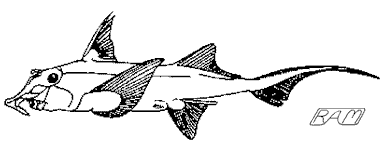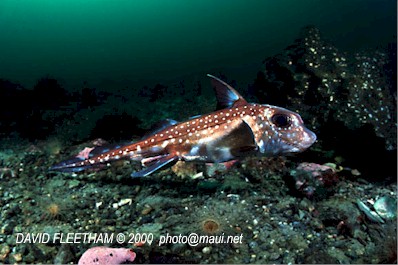Chimaeras —
The Neglected Chondrichthyans

The class Chondrichthyes is usually divided into two sub-classes. The sharks and rays belong to the subclass Elasmobranchii and the chimaeras (also known as ratfishes and ghost sharks) to the subclass Holocephali.
As the name 'chimaera' suggests, holocephalans combine an odd mix of characteristics. Among other features, they are characterized by: a gill cover over the four gills, leaving a single opening on each side of the head; the palatoquadrate (upper jaw) is usually fused to the cranium; no spiracle opening behind the eye; branchial (gill) basket mostly beneath the neurocranium (posterior part of the cranium that encases the brain); teeth relatively few (one pair in the lower jaw and two pairs in the upper), occurring as mineralized grinding plates; tooth plate replacement is slow; no cloaca, but with separate anal and urogenital openings; skin in adults 'naked' (without dermal denticles); no stomach or ribs; and males — in addition to the pelvic claspers — have an accessory clasping organ on the head.
On the whole, chimaeras are rather peculiar-looking, deep-sea fishes. They have a disproportionately huge head (Holocephali means 'whole head') pocked with large, well-developed eyes. They have an odd, rabbit-like mouth filled with plate-like grinding teeth. The tail is tiny and often streamer-like, so for propulsion chimaeras rely instead on flapping their large, wing-like pectoral fins. Chimaeras in 'flight' resemble a kind of weird cross between a fish and an angel.
 Looking
like a creature assembled by a committee that just couldn't agree, the Elephant
Fish (Callorhinchus milii) is commercially harvested in New Zealand
waters during spring and summer months. A recent study by Malcolm P. Francis has
shown that between the 1960's and 1980's, Elephant Fish in Pegasus Bay and
Canterbury Bight have increased their growth rates 33 to 56% and reduced their
age at maturity by 1 or 2 years. This increased productivity may represent an
Elephant Fish survival strategy in response to increased mortality due to
on-going predation by New Zealand commercial fishermen.
Looking
like a creature assembled by a committee that just couldn't agree, the Elephant
Fish (Callorhinchus milii) is commercially harvested in New Zealand
waters during spring and summer months. A recent study by Malcolm P. Francis has
shown that between the 1960's and 1980's, Elephant Fish in Pegasus Bay and
Canterbury Bight have increased their growth rates 33 to 56% and reduced their
age at maturity by 1 or 2 years. This increased productivity may represent an
Elephant Fish survival strategy in response to increased mortality due to
on-going predation by New Zealand commercial fishermen.
Some 42 species of living chimaera are known, divided into three families.
Chimaeridae
The family Chimaeridae includes the shortnose chimaeras or ratfishes, with two genera (Chimaera and Hydrolagus, the latter means 'water rabbit') and about 31 species.
Perhaps the best-known species is the Spotted Ratfish (Hydrolagus colliei) of the west coast of North America. Females of this species produce only two eggs at a time, packaged in capsules that resemble tiny violin-cases. The eggs require what must be an unpleasantly long time to extrude and may trail behind a female for 4 to 6 days before dropping off. The Spotted Ratfish is frequently encountered at night by scuba divers off Washington and British Columbia. At night, this ratfish flaps over expansive plains of fine mud in water 20 to 60 feet (6 to 18 metres) deep. It grows to a length of almost three feet (one metre), has silvery-bronze flanks sprinkled with white spots, and gorgeous emerald eyes that reflect a diver's torchlight like cats' eyes, bringing a special magic to what might otherwise be a rather dull dive.
This individual Spotted Ratfish (Hydrolagus colliei) is a male, identifiable by the paired, sausage-like claspers behind its pelvic fins and the doorknocker-like cephalic tentaculum on its forehead. The cephalic tentaculum has an opposable tip, enabling the male Spotted Ratfish to grasp a receptive female by a corresponding 'hollow' on her nape.
Photo © David Fleetham david@davidfleetham.com; used with the gracious permission of the photographer.
Rhinochimaeridae
The family Rhinochimaeridae includes the longnose chimaeras, with three genera (Harriotta, Neoharriotta, and Rhinochimaera) and about 8 species. Longnose chimaeras are deep-sea fishes that, as a group, are very poorly known.
Callorhinchidae
The family Callorhinchidae includes the plownose chimaeras, with a single genus (Callorhinchus) represented by 3 species. Collectively, the plownose chimaeras among the most goofy-looking critters in all of fishdom, having a large transverse plate mounted on the end of the nose like a fleshy metal-detector. The plate is studded with electroreceptors (ampullae of Lorenzini) and is probably used to detect buried prey.
The best-known species is the Elephant Fish (Callorhinchus milii), which is an important food fish off New Zealand. Growing to a length of about 4 feet (1.2 metres), the Elephant Fish lives over the continental shelves as deep as 660 feet (200 metres). Adults migrate inshore during the austral spring to shallow grounds where mating and egg-laying take place. The eggs are contained in a yellowish-brown case, measuring about 4 by 10 inches (10 by 25 centimetres), and are laid on sand or mud in water less than 130 feet (40 metres) deep. The young hatch 6 to 8 months later (May-July) at a length of about 4 inches (10 centimetres) and — like most chondrichthyans — are slow growing, taking about 4 to 5 years to reach maturity. The Elephant Fish is caught commercially during the inshore migration, either in trawls or set nets. Total annual landings are about 1,000 tons (1,000 tonnes). The firm white fillets are either used locally in the fish and chip trade or are exported to Australia. It seems a shame that such a wonderfully implausible creature should end up deep-fried and dolloped with tartar sauce.

